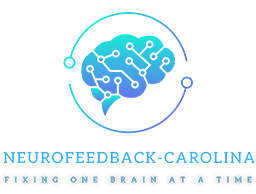Neurofeedback Research
Neurofeedback has shown to be an effective approach for many brain-based disorders. Explore the resources below to get informed below about the ongoing research on this innovative form of biofeedback that has been around since the 1960s. Our Rock Hill, SC clinic, Neurofeedback Carolina, has been treating patients with common brain-based conditions for years. Contact us and set up a free initial consultation to learn more.
Neurofeedback Ebook
Dr. Ed Carlton, a fellow neurofeedback provider, offers this ebook to anyone wanting more information on how the process works. Written in plain English, it explains the neurofeedback process, including case studies, and a personal story of how neurofeedback eliminated the need for bipolar medications.
ADHD
During the past three decades, a series of case and controlled group studies examining the effects of EEG biofeedback have reported improved attention and behavioral control, increased cortical activation on quantitative electroencephalographic examination, and gains on tests of intelligence and academic achievement in response to this type of treatment. This review paper critically examines the empirical evidence, applying the efficacy guidelines jointly established by the Association for Applied Psychophysiology and Biofeedback (AAPB) and the International Society for Neuronal Regulation (ISNR). On the basis of these scientific principles, EEG biofeedback was determined to be “probably efficacious” for the treatment of ADHD. Although significant clinical improvement was reported in approximately 75% of the patients in each of the published research studies.
Autism
Nada Pop-Jordanova, Tatjana Zorcec, Aneta Demerdzieva, Zoran Gucev Pop-Jordanova et al. Nonlinear Biomedical Physics 2010
Autistic spectrum disorders are a group of neurological and developmental disorders associated with social, communication, sensory, behavioral, and cognitive impairments, as well as restricted, repetitive patterns of behavior, activities, or interests. The aim of this study was a) to analyze qEEG findings of autistic patients and to compare the results with the database, and b) to introduce the calculation of spectrum weighted frequency (brain rate) as an indicator of general mental arousal in these patients. Results: Results for qEEG shows generally increased delta-theta activity in the frontal region of the brain. Changes in the qEEG pattern appeared to be in a non-linear correlation with maturational processes. Brain rate measured in CZ shows slow brain activity (5. 86) which is significantly lower than normal and corresponds to low general mental arousal. Recent research has shown that autistic disorders have as their basis disturbances of neural connectivity. Neurofeedback seems capable of remediating such disturbances when these data are considered as part of treatment planning. Conclusions: Prognosis of this pervasive disorder depends on the intellectual abilities: the better intellectual functioning, the possibilities for life adaptation are higher qEEG shows generally increased delta-theta activity in the frontal region of the brain which is related to poor cognitive abilities. Brain rate measured in CZ shows slow brain activity related to under arousal. Pharmacotherapy combined with behavior therapy, social support, and especially neurofeedback technique promises slight improvements.
Click Here To View Full Article
Anxiety and Depression
In evaluating the studies in the overall broad area of the neurofeedback treatment of anxiety disorders, EEG biofeedback (neurofeedback) qualifies for the evidence-based designation of being an efficacious treatment. EEG biofeedback is an exciting, cutting-edge technology that offers an additional treatment alternative for modifying dysfunctional, biological brain patterns that are associated with various psychiatric conditions
Click Here To View Full Article
Insomnia
Arns, M., Swatzyna, R.J., Gunkelman, J. et al. Sleep maintenance, spindling excessive beta and impulse control: an RDoC arousal and regulatory systems approach?. Neuropsychiatr Electrophysiol 1, 5 (2015).
Background
In 2009 the United States National Institute of Mental Health (NIMH) introduced the Research Domain Criteria (RDoC) project, which intends to explicate fundamental bio-behavioral dimensions that cut across heterogeneous disorder categories in psychiatry. One major research domain is defined by arousal and regulatory systems.
Methods
In this study we aimed to investigate the relation between arousal systems (EEG-beta phenotypes also referred to as spindling excessive beta (SEB), beta spindles or sub-vigil beta) and the behavioral dimensions: insomnia, impulsivity/hyperactivity and attention. This analysis is conducted within a large and heterogeneous outpatient psychiatric population, in order to verify if EEG-beta phenotypes are an objective neurophysiological marker for psychopathological properties shared across psychiatric disorders.
Results
SEBs had an occurrence between 0–10.8% with a maximum occurrence at frontal and central locations, with similar topography for the heterogeneous sample as well as a more homogenous ADHD subgroup. Patients with frontal SEBs only, had significantly higher impulsivity/hyperactivity (specifically on impulse control items) and insomnia complaints with medium effect sizes.
Conclusions
Item level and mediation analysis revealed that sleep maintenance problems explained both frontal SEB EEG patterns (in line with SEB as a sub-vigil or hypoarousal EEG pattern) as well as the impulse control problems. These data thus suggest that frontal SEB might be regarded as a state marker caused by sleep maintenance problems, with concurrent impulse control problems. However, future longitudinal studies should investigate this state-trait issue further and replicate these findings Also studies manipulating SEB by for example neurofeedback and measuring consequent changes in sleep and impulse control could shed further light on this issue.
Click Here to View the Article
Migraines
Deborah A Stokes, Martha S Lappin Behavioral and Brain Functions 2010, 6:9
Traditional peripheral biofeedback has grade A evidence for effectively treating migraines. Two newer forms of neuro biofeedback, EEG biofeedback, and hemoencephalography biofeedback were combined with thermal hand warming biofeedback to treat 37 migraineurs in a clinical outpatient setting. Methods: 37 migraine patients underwent an average of 40 neurofeedback sessions combined with thermal biofeedback in an outpatient biofeedback clinic. All patients were on at least one type of medication for migraine; preventive, abortive or rescue. Patients kept daily headache diaries a minimum of two weeks prior to treatment and throughout treatment showing symptom frequency, severity, duration, and medications used. Treatments have been conducted an average of three times weekly over an average span of 6 months. Headache diaries were examined after treatment and a formal interview was conducted. After an average of 14.5 months following treatment, a formal interview was conducted in order to ascertain the duration of treatment effects.
Click Here To View Full Article
Resources for More Neurofeedback Studies
The International Society for Neurofeedback and Research maintains a comprehensive bibliography of research articles discussing conditions that are positively affected by neurofeedback by D. Corydon Hammond, Ph.D., Professor, Physical Medicine & Rehabilitation, University of Utah School of Medicine, and D. Allen Novian, Ph.D., LMFT, LPC-S, Adjunct Professor, Neurofeedback and Biofeedback, St. Mary’s University. ISNR also has an editorial in defense of EEG biofeedback.
The Association for Applied Psychophysiology and Biofeedback published Evidence-Based Practice in Biofeedback and Neurofeedback (3rd ed.) which provides the most comprehensive and up-to-date evidence-based and neuroscientifically supported information on the subject. They also have more information for consumers.
Get Started with Neurofeedback Training in Rock Hill SC
Find out if neurofeedback can help you at Neurofeedback Carolina, located in the heart of Rock Hill, South Carolina. If you’re ready to explore how neurofeedback training can help you or a loved one, call us at (803) 992-3510 or schedule your free initial consultation with no strings or obligations attached. Find out more about how neurofeedback works and learn about the success we have had with individuals just like yourself.



